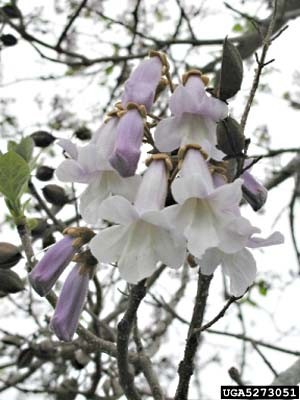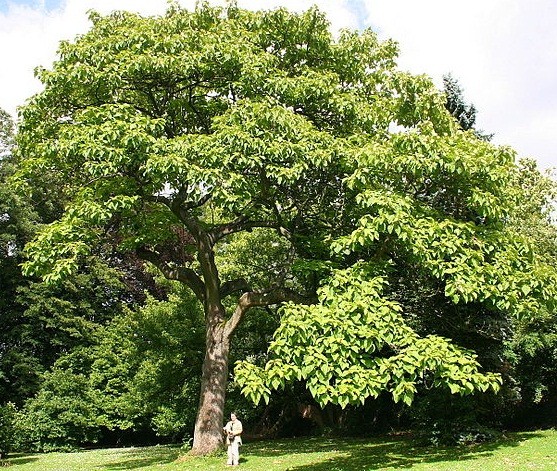Paulownia tomentosa
Princess Tree / Empress Tree
Synonyms: Paulownia imperialis, Bigononia tomentosa
Class: Magnoliopsida
Order: Lamiales
Family: Scrophulariaceae


Photographer: Leslie J. Mehrhoff Photographer: Jean-Pol GRANDMONT
Source: Bugwood.org Source:WikiCommons
Description
The genus Paulownia is in honor of the Grand Duchess Anna Pavlovna of Russia. Paulownia tormentosa it is a fast growing and hardy deciduous tree that can easily grows over 50 feet tall. Leaves are heart-shaped and 5 to 12 inches long, with a velvety texture. The characteristically large-showy flowers is why this tree has spread world-wide as an ornamental. The white to purple (when mature) flowers are tube-like and up to 2 inches long with a nice vanilla-like fragrance. The bark is rough, gray brown interlaced with smooth/shiny areas. The fruit is a dry brown capsule that may contain several thousand winged seeds. Seed capsules mature in the autumn and remain attached all winter which is a useful identification aid.
Ecological Threat: Paulownia tormentosa is an aggressive and highly adaptable ornamental tree that grows rapidly. Also, its ability to sprout prolifically from adventitious buds on stems and roots allows it to survive fire, cutting and even bulldozing in construction areas; making it difficult to remove from established areas.
Biology: Flowers bloom before the leaves begin to emerge in late April or early May. Leaf expansion begins about 2 weeks after flowering. Flower buds begin to appear in the leaf axils in late July or early August. Seeds mature in September, and capsules ripen and open in October. The capsules may remain on the tree for long periods. The capsules break open and seeds are disseminated by wind throughout winter and into spring. The small, light, winged seeds of princess tree are easily transported by wind and water over considerable distances. Seeds can survive in the soil seed bank for at least 2 to 3 years. Vegetative regeneration is important to princess tree's persistence and spread because sprouting may allow an individual to persist after defoliation or disturbance.
History: Imported to Europe by the Dutch East India Company in the 1830s and brought to North America soon after. Princess tree appears to be more invasive in North America than in Europe; and unfortunately this tree is commercially farmed in the United States.
U.S. Habitat: The princess tree occurs in a variety of disturbed, high-light environments such as forest gaps and edges, stream banks and scoured riparian areas, steep rocky slopes, roadsides, fence-rows and vacant lots.
Texas Observations by Citizen Scientists here
Distribution
Native Origin: Eastern and central China
U.S. Present: AL, AR, CT, DC, DE, FL, GA, IL, IN, KY, LA, MA, MD, MO, MS, NC, NJ, NY, OH, OK, PA, RI, SC, TN, TX, VA, WA, WV
Resembles/Alternatives
The princess tree looks like the dragon tee (Paulownia fortunei), southern catalpa (Catalpa bignonioides) or the northern catalpa (Catalpa speciosa). The dragon tree is very similar because it is in the same genus but the flowers are lighter (lavender) and the dragon tree can grow up to 70 feet, while the princess tree grows just over 50 feet. One can tell the difference between the southern and northern catalpas from the princess tree by the flowers, which are white with purple streaks/spots and the bark is a different texture and coloration.
Management
The princess tree can be controlled using an integrated management strategy. Cutting or girdling trees with power or manual saws are effective at preventing seed production, but an herbicide treatment is necessary following cutting since Paulownia readily re-sprouts. Hand pulling may be effective for young seedlings. Plants should be pulled as soon as they are large enough to grasp. Seedlings are best pulled after a rain when the soil is loose. The entire root must be removed since broken fragments may re-sprout. Cutting or pulling is the preferred mechanical treatments of the Paulownia tormentosa; do not use fire because this species is able to survive fire and then quickly proliferates and out-competes native tree species post-fire.
References
Cunningham, T.R., S.B. Carpenter. 1980. The effect of diammonium phosphate fertilizer on the germination of Paulownia tomentosa seeds. Tree Planter's Notes 31:6-8.
Woodward, Susan L., and Joyce Ann. Quinn. 2011. Princess Tree. Encyclopedia of Invasive Species: From Africanized Honey Bees to Zebra Mussels. Santa Barbara, CA: Greenwood. 565-567. Print.
Internet Sources
http://plants.usda.gov/core/profile?symbol=PATO2
http://www.fs.fed.us/database/feis/plants/tree/pautom/all.html#SITE%20CHARACTERISTICS
http://dendro.cnre.vt.edu/dendrology/syllabus/factsheet.cfm?ID=145
http://www.texasinvasives.org/observations/search.php?sn=PATO2&search=go
http://pick4.pick.uga.edu/mp/20q?search=Paulownia+tomentosa#http://www.issg.org/database/species/ecology.asp?si=440&fr=1&sts=&lang=EN
 Texas Invasive Species Institute
Texas Invasive Species Institute